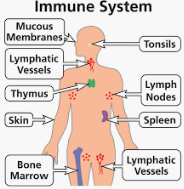IMMUNE SYSTEM Multiple Choice Questions :-
1. Lack of reaction to our own human leukocyte antigens (HLAs) is known as?
A. autoimmunity
B. complement system
C. clonal selection
D. tolerance
Answer: D
2. Which of the following components of the vertebrate immune response occurs first upon invasion by a virus or bacterium?
A. Activation of killer T lymphocytes
B. Activation of B lymphocytes
C. The inflammatory response
D. Mobilization of complement proteins
Answer: C
3. Which of the following white blood cells act as scavengers when they engulf and digest pathogens?
A. Macrophages
B. T cells
C. B cells
D. Lymphocytes
Answer: A
4. A cell which defends against body cells in which viruses are reproducing is
A. Exotoxin
B. Cytotoxic T cell
C. Endotoxin
D. Suppressor T cell
Answer: B
5. Which of the following is most likely to produce anaphylaxis in a susceptible individual?
A. Pollen
B. Mold
C. Dust
D. Bee sting
Answer: D
6. What type of B cell remains dormant in the body, but can respond rapidly if the same antigen appears again?
A. T cells
B. Memory cells
C. Plasma cells
D. Macrophages
Answer: B
7. The maturation of T cells and the production of particular T cell receptors occurs in the
A. thyroid gland
B. thymus gland
C. testes
D. all of these
Answer: B
8. Which of the following provide specific defense against viruses and bacteria?
A. T cells
B. B cells
C. Complement
D. inflammation
Answer: B
9. Which of these is a type of specific defense against pathogens?
A. Lymphocytes
B. Macrophages
C. Phagocytes
D. Leukocytes
Answer: A
10. In animals, blood clots serve the function of
A. consuming invading organisms
B. helping them match the background coloration of the habitat
C. stimulating production of killer T lymphocytes
D. repairing damage to the body wall
Answer: D

IMMUNE SYSTEM Objective Type Questions with Answers
11. What is the result of invasion of a body by pathogens?
A. Infection
B. Inflammation
C. Swelling
D. Pus
Answer: A
12. What is the behavior in which T cells and B cells constantly travel throughout the body seeking out and destroying foreign substances?
A. Antibody-mediated immune response
B. Immune surveillance
C. Cell-mediated immune response
D. Vaccination
Answer: B
13. In a fetus, where are lymphocytes produced?
A. In the spleen
B. In the bone marrow
C. In the liver
D. In the heart
Answer: C
14. Which of the following produces the antibodies employed in the specific immune response of vertebrates?
A. B lymphocytes
B. T lymphocytes
C. Neutrophils
D. Macrophages
Answer: A
15. Which of the following is not part of the vertebrate immune system?
A. Lymphocytes
B. Antibodies
C. Cardiac glycosides
D. Lymph nodes
Answer: C